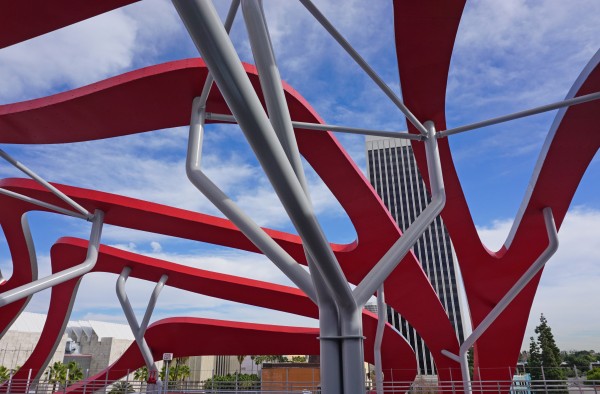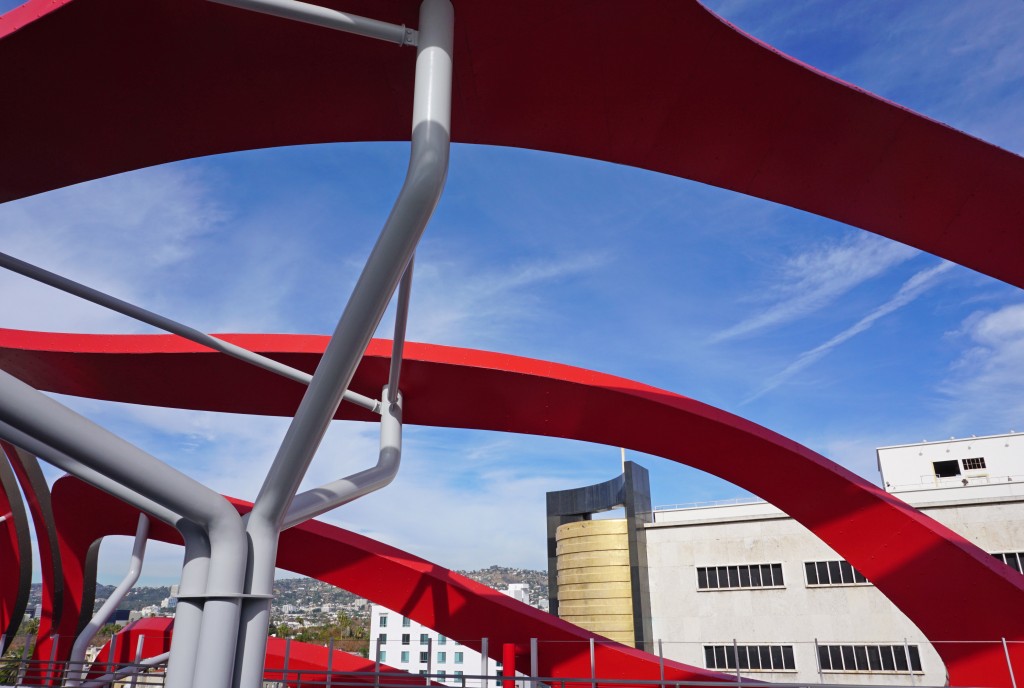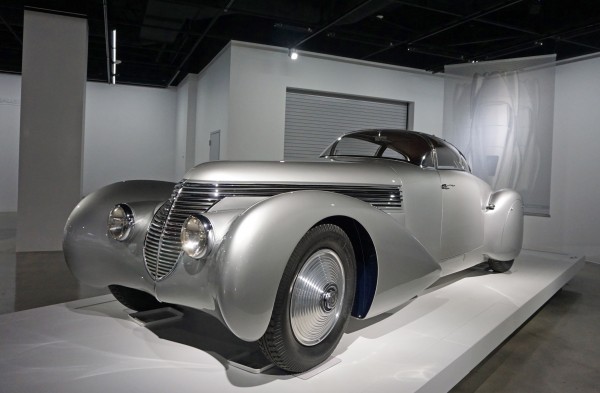The Petersen Automotive Museum reopened Sunday December 6, after a radical remodeling that took 13-months and cost $125 million, sporting a stunning new exterior of huge silver waves circling a bright red structure, an impressive sight that cannot be ignored by anyone driving by.
The building at the corner of Wilshire and Fairfax was originally constructed in 1962 as a branch of the Japanese luxury department store Seibu, with a tea room and koi pond on the roof, on the Miracle Mile, that had been developed by A.W. Ross in the 1920s as a shopping district. But shoppers did not show enough interest for those expensive foreign goods, so the store closed in 1964 and the prime location was taken over by Ohrbach’s, a moderately-priced American Department store, that occupied 6060 Wilshire Blvd until 1986. The building remained vacant until 1994, when publisher Robert Petersen (who died in 2007 at age 80), a car enthusiast who had started Hot Rod and Motor Trend magazines, bought it to house his car collection, and create a museum honoring automobile culture. The 1994 renovation added a facade featuring gigantic vertical fins inspired by Googie design motifs.

Eugene “Gene” Kohn, chairman of the New York architectural firm Kohn Pedersen Fox, in charge of the current remodeling with lead designer Trent Tesch, explains the concept behind their design: “We wanted to give this building new life, express its use, create a work of fine art; so we came up with the bold idea of moving, curving ribbons to represent the motion and speed of a car, the aerodynamic quality of an automobile. We used stainless steel for permanence and beauty, and the color red of the Ferrari race cars, for a structure that is meant to be seen by driving in a car, not by walking as pedestrians. It is lit from the inside at night for a color-changing effect.”
The press opening on December 3 was a festive affair, with a cooking demonstration and tasty appetizers from the Drago Brothers (Celestino, Tanino, Giacomino and Calogero), who arrived to the US from Messina, Sicily in the 80s, and are now the celebrated chef owners of several Italian restaurants in the Los Angeles area. They will soon open a new restaurant inside the museum. This social event, that took place on the rooftop terrace, afforded spectacular views of the giant ribbons (painted “hot rod” red on the inside, like the corrugated aluminum that covers the walls, and supported by vertical tree-like clusters holding up horizontal outriggers), against the blue sky and the surrounding buildings of this stretch of Wilshire that is called Museum Row. This sparkling new addition joins LACMA, the Broad Contemporary Art Museum, the La Brea Tar Pits Museum, and the future Academy Museum of Motion Pictures, inside and behind the 1939 Streamline Moderne May Company department store across the street, with its gold cylindrical facade.

Extensive renovation also took place on the inside of the museum, with the addition of a third floor of gallery space and a new spiral staircase connecting the three floors, for 95,000 square feet of brand-new displays in 25 galleries. Giant video screens and interactive exhibits line the walls, in the hope of attracting young visitors and encouraging repeat visits. These gleaming and brightly-lit galleries are a far cry from the dark and dingy interior that I used to visit, when attending talks organized here by Zocalo Public Square. But there is a lot to see, and you should come and explore the place for yourselves. I only highlight two vehicles representative of car culture around the world.

The one-of-a-kind 1938 Dubonnet Xenia, displayed in a “Precious Metal” gallery showcasing luxury cars painted silver or chrome plated. French racecar driver and inventor André Dubonnet, heir to his family’s wealth, had this striking car custom-built to showcase a new suspension system of his own design. He called it Xenia, after the Greek word meaning hospitality.

A red 1910 Ford Model T Roadster. Nicknamed “Tin Lizzie,” the Model T was the first affordable car made in America and it popularized this new method of transportation. It was mass produced in Detroit on an assembly line with interchangeable parts, with this stated goal by Henry Ford: “I will build a car for the great multitude so low in price that no man making a good salary will be unable to own one, and enjoy it with his family.” It came in many models and different colors, until 1913 when Ford, to cut costs, decided that the only color available would be black. It cost $825 in 1909 and could be bought for $260 in 1925. 15 million Model Ts were sold between 1909 and 1927.
This newly redesigned museum is perfect for Los Angeles, a city that is considered the capital of car culture. But that perception historically favored the development of freeways at the expense of public transportation, causing pollution and traffic. As the signal of a reversal of this trend, a new Metro station is under construction on Wilshire East of Fairfax. Unfortunately it’s not scheduled to open until 2023, with the completion of the Purple Line to Westwood around 2035, 20 years from now…
Featured photo by David Zaitz. Other photos by the author.
